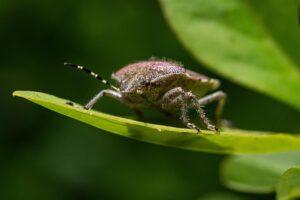ELTE: Bugs may have played a greater role in pollination in earlier stages of geological history
Bugs may have played a greater role in pollination in earlier stages of geological history – Hungarian researchers have confirmed based on the examination of an ancient bug found in almost a hundred million-year-old Burmese amber.

(Photo: Pixabay)
According to an ELTE statement on Tuesday, the researchers reported their results in the scientific journal Scientific Reports on August 19. As they wrote, the examination of amber inclusions is an important tool for exploring the biodiversity of ancient times and various evolutionary patterns. The imprint fossils of certain groups of organisms (such as arthropods) are often poorly preserved, not very detailed, and are only preserved in good condition in the fossilized resin. One important such find from the middle period of geological history (Mesozoic) is Burmese amber (also known as burmite). Burmese amber originated in the Late Cretaceous, about 99 million years ago, on the landmass called the West Burmese terrane, which had separated from the supercontinent Gondwana more than a hundred million years ago and was located in the equatorial part of the Tethys Ocean until the Late Eocene. Although its fauna is of Gondwanan origin, it has developed in isolation for millions of years, and is therefore rich in unique flora and fauna. While studying such an inclusion, Péter Kóbor, a researcher at the Plant Protection Institute of the HUN-REN Agricultural Research Center (ATK), and Márton Szabó, a colleague of the Paleontological and Geological Collection of the Hungarian Museum of Natural History and the Department of Paleontology of ELTE (Eötvös Loránd University), came across a bark beetle (from the Aradidae family), which is the first known representative of the ancient (plesiomorphic) Prosympiestinae subfamily from the Burmese amber fauna.
According to the announcement, the discovery of the insect is also interesting in relation to the family
The bark beetles known so far from Burmese amber were all representatives of modern (apomorphic) groups, while more ancient groups were missing from the “species pool”. What makes the bug, named Shaykayatcoris michalskii, truly special is its iridescent (showy) blanket, which has never been seen before in this family. Although iridescence is not uncommon among bugs, it is particularly unusual in groups with a hidden lifestyle, such as bark beetles. True to their name, these bugs live mostly under the bark of trees and feed on fungal filaments. This lifestyle includes morphological adaptations such as a body that is strongly flattened in the dorsal-ventral direction, or the strongly elongated bristles that are held coiled in the head capsule when at rest. Representatives of the Prosympiestinae subfamily stand out from the crowd in both their lifestyle and morphology: their bodies are rather cylindrical, and they live mainly in leaf litter or under logs and branches lying in leaf litter. Iridescence may have two functions. It may serve as a deterrent if it is brightly colored (such as red) and has a striking pattern, but this is unlikely in this case, because the bedbug’s base color is brown. It may also function as camouflage, helping the insect blend in with the floral environment. As they wrote, this explanation is more likely.
The amber contained plant debris and a large amount of pollen around the animal, and even had pollen stuck to its body
This, as well as the iridescent coloration, suggests that this bedbug may have been a flower visitor, so it probably also played a pollinator role. “The find confirms that the role of bedbugs in flower visiting and perhaps pollination may have been much more significant in earlier stages of evolution than we see today. Most modern bedbugs are no longer flower visitors, and have probably been displaced from this ‘market’ by other, more specialized pollinators (such as bees),” they wrote in the statement. The discovery helps us understand how today’s insect world evolved, how individual species responded to competition and environmental changes. “Armed with this knowledge, we can also more easily navigate current ecological and agricultural challenges, such as the decline of pollinators,” the statement reads.
MTI
Related news
AM: Government helps farmers with a loan moratorium
🎧 Hallgasd a cikket: Lejátszás Szünet Folytatás Leállítás Nyelv: Auto…
Read more >More than 100 Hungarian farmers also demonstrated in Brussels
🎧 Hallgasd a cikket: Lejátszás Szünet Folytatás Leállítás Nyelv: Auto…
Read more >NAK: Domestic producers await customers with an ample supply of all pine species
🎧 Hallgasd a cikket: Lejátszás Szünet Folytatás Leállítás Nyelv: Auto…
Read more >Related news
New Year’s Eve: shortened opening hours in stores – general store closure on January 1
🎧 Hallgasd a cikket: Lejátszás Szünet Folytatás Leállítás Nyelv: Auto…
Read more >Tejföl is only a name for live flora: new categories for sour dairy products will be introduced from 2026
🎧 Hallgasd a cikket: Lejátszás Szünet Folytatás Leállítás Nyelv: Auto…
Read more >Sausage prices before New Year’s Eve: cheap entry, expensive premium – how big is the gap on the shelves?
🎧 Hallgasd a cikket: Lejátszás Szünet Folytatás Leállítás Nyelv: Auto…
Read more >






